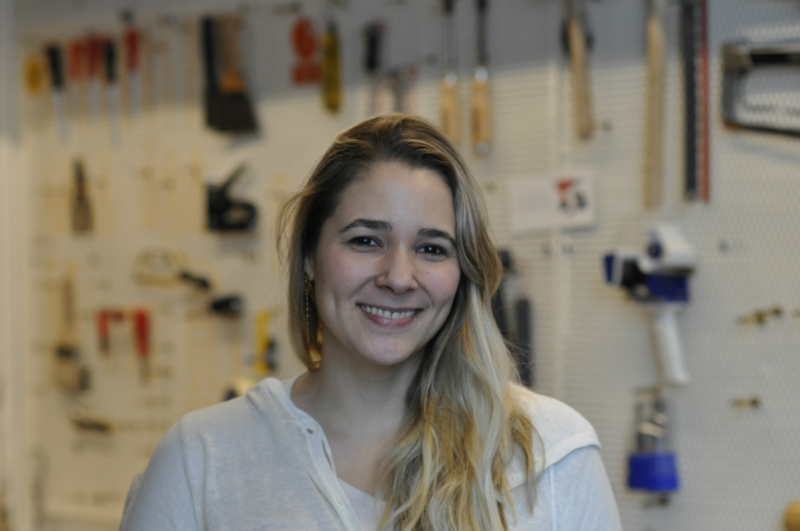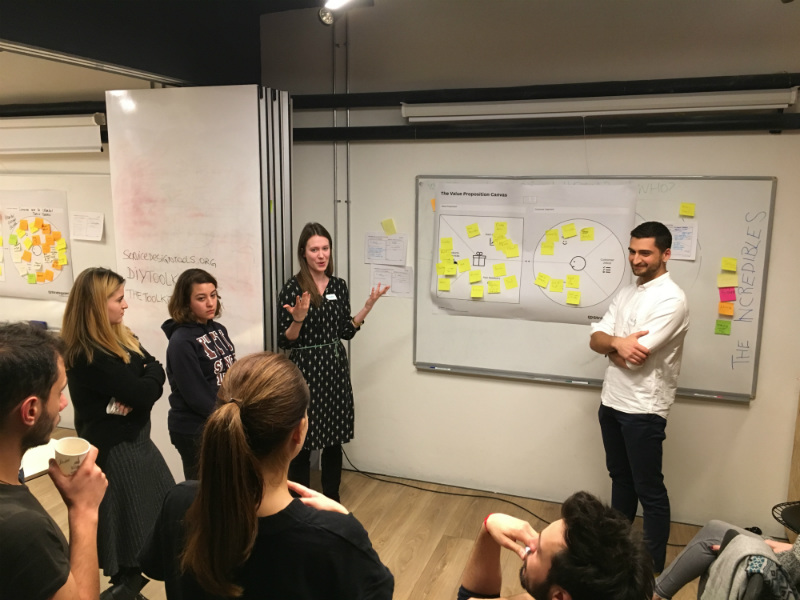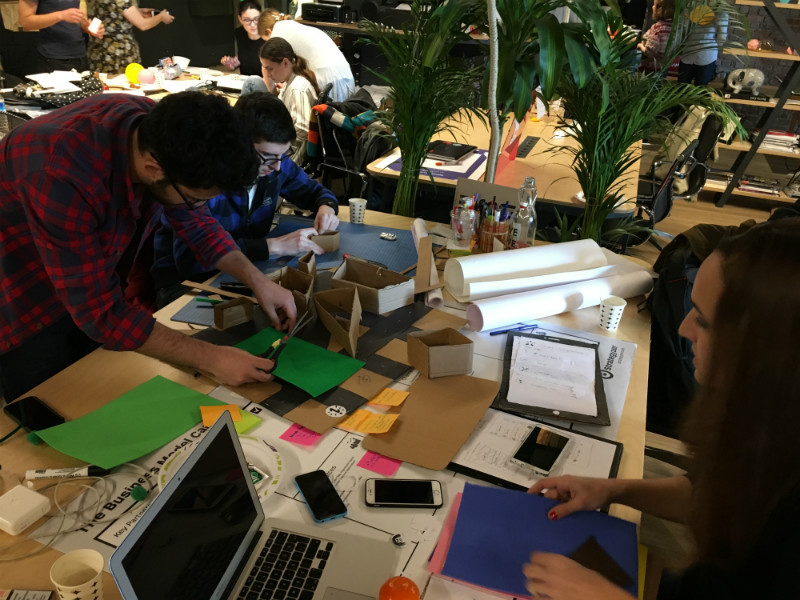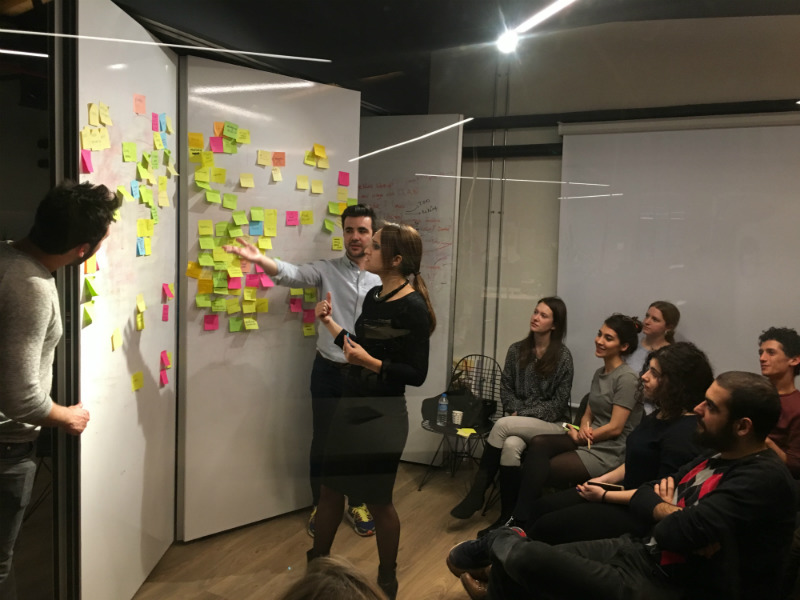Carla Lemgruber traveled quite a distance from Rio de Janeiro in pursuit of love so that she could set roots here in Istanbul. A designer at heart, Carla’s wide skill set incorporates everything from the research and design side to consulting and strategy. It’s common to find her at ATÖLYE collaborating with members of the community, getting directly involved or offering advice and feedback on a variety of projects. Carla also happens to be a main showrunner behind the recently successful Istanbul Service Jam, part of the Global Service Jam, offering participants the opportunity to design, prototype and share innovative service designs on a global scale.
Carla sat down with Yabangee to talk about her experiences as both an expat and a designer, enlightening us a great deal on some of the finer aspects of the field. We also gained some insight into the organizational side of a service jam and reflected on ever-relatable themes of starting a new life abroad.

Could you tell us a little bit about what brought you to Istanbul?
It was actually a six-year long-distance relationship. I met my husband, who is Turkish, at a design event in Germany. Then we stayed in a long-distance relationship for some time trying to figure out what to do. I finally came in April 2015, so it has been almost two years now.
Happy with your decision?
Yes. Not only on a personal level. Long-distance relationships can be really torturous. I have found Istanbul to be very fulfilling for me in many other ways as well.
You seem to be involved in and skilled at a lot of various fields, especially regarding design. Could you give us a bit more insight into your professional scope?
I started in product design as my bachelor’s. I like the idea of fixing problems and trying to create better objects for daily life. I was also very innovation oriented instead of aesthetic oriented. There are designers who like to create shapes. I like to create different concepts, with relevance or providing new meaning. So after that, I decided to study in Milan for service design, because I understood at some point that product design isn’t enough. They solve practical things, but service design embraces a bigger picture. It involves how people communicate, how they design processes, how the experience things. It is something that becomes more broad than just an object. It’s the full experience.

Could you go into a bit more detail on what service design is?
It’s funny because I was thinking of how to best explain it for the Global Service Jam. Service design is actually a bit mysterious. People don’t usually think that a service can be designed. For example, when you pay for a service like going to the hairdresser or a baker or something like that. You don’t think you can design anything other than visuals for the store or a pamphlet or this kind of thing. What service design does is… it’s like being the conductor in an orchestra. You still need really good musicians. You need a good product designer, a good interior designer, UX designers for website and mobile, etc. What a service designer does is map the journey of the client. When you enter the restaurant, what is the first thing you do? Do you give your name at the door? Then you arrive and sit at a table. Then someone will come and take your order. Then you eat and then you go pay. We make this little story of how things could happen and how it could be better. So how can we make it more interesting or magical? How can we make it easier in the case of things like bank services or other kinds of services. From then on, you can think of mobile apps, websites, signs, space, etc. It gives solutions and then experts from each field can design. Everything becomes a more integrated, linked experience instead of services being provided separately.
What has your experience been like since moving here in this regard? Is it easy being a foreigner involved in this field? Has your work been more locally focused or are you working for projects abroad?
When I arrived it was hard to do service design in Turkey. Especially when you do design with design thinking methods, they require an initial step of studying, understanding customers and customer issues. So we go to the place, talk to people, learn about the problems and what could be better, what do people dream about. From that, you design the experience for both the customer and the business owner. That research part is really hard due to lack of language. So I had some opportunities to do some field research and strategies but I couldn’t accept because I didn’t have any connections that would facilitate the work. I ended up doing most jobs with Brazil remotely and not even necessarily service design related. I had to go a little bit out of my area and do web design, invitation for weddings and more basic projects that help give a bit money. Since I found ATÖLYE, it has helped open a lot of doors for me. Here I can work on a team. Other people can conduct the research, but I can still be overseeing it, helping and so on.

How long have you been based out of ATÖLYE and how does it fit in?
I came to ATÖLYE in July of last year, out of a traveling experience I went on with my husband to the USA to meet my parents. He had to work there and he discovered a co-working space there that he really liked. It was a really brilliant insight for foreigners all over the world. If you can find one that is community-based like ATÖLYE, for example in something like my field of design, it really helps with networking connections as well. I highly recommend foreigners who live abroad to find these kinds of places where they can interact with people. It also helped on a personal level. I was able to make friends, meet people who can speak English and get out of my husband/family bubble. It’s hard for foreigners. You’ve literally left everyone you know in another place. I’ve been here since July, so the first few months were about meeting new people and making new friends. The past few months have been more work related and I was able to enter my first collaborative project last month.
What are some of the challenges you’ve faced since moving here?
I think generally people who move abroad think that language, food and the more obvious differences are going to be the bigger challenges, but they’re not. You find ways to communicate with people, you find friends that speak English, you can always find food that you like and Turkish food is really good. I think the mentality is different. You are hard-wired in your mind in a different way. For me, it’s hard to get used to the chaotic side of things. Like traffic with how people constantly change lanes like crazy or how people go out for coffee at 10:00 PM. In Brazil, we’re used to going to sleep early and waking up early. We’re not used to the winter time schedule. Our schools and universities start at 7:00 AM. By 10:00 PM you’re usually in bed and you wouldn’t call anyone because it might be rude. Here, people call each other at 11:00 PM for a coffee. I’m thinking how can I get a coffee now if I have work in the morning? It’s hard sometimes.
For instance, if you go to a Turkish dinner, everything is reversed. In Brazil, you’ll have some cheese and snacks for an appetizer, then you have the dinner and dessert and it’s finished. Here, you have the main meal, then there’s some appetizers, then fruit and sweets and it goes on for hours. I was so full during my first experiences because I didn’t want to refuse and be impolite. Also, the food is really good. But it just keeps coming and it becomes complicated. People are also really, really nice here which has been a good experience. Turkish people are very helpful and if you mention a difficulty and will help you if they can. In Brazil, people can be more individualistic, they will help you if they can, when they can. Here, people will go more out of their way to help you. Also, safety issues. We might have the terrorist issues, but there isn’t much street violence or robbery. Although I might be scared of the macro dangers, I like that I can just go home by myself with the car at 11:00 PM and not be scared that I’m going to turn on a wrong street and wind up in a favela. The safety issue allows you to explore the city more and feel safer on a daily basis.
We’ve noted that you’ve been heavily involved in the Global Service Jam. Could you give us a bit of insight into it and the general experience behind being an organizer?
While I was studying in Milan, I saw this jam event happening a couple of times, but they were unfortunately at times when I was coming to Turkey to visit my then boyfriend and I couldn’t attend. The basic idea of the event is that you have a theme, it’s a mystery so nobody knows until it starts, and many cities around the world, more than 100 different locations, they use the design thinking process to think of service ideas that can help people, society, the world… There are jams focused on government issues, jams focused on sustainability, it depends on the type of the jam. The basic idea is that you cover the whole design thinking process. It includes research and talking to people, understanding the issues, framing the project, creating solutions and testing them in any way you can. You try to cover all the steps with very basic tools like sketching and that kind of stuff. You generate some cool ideas and share them with the whole world. Everyone uploads their projects in the end and talks with each other. We’ll have Skype sessions and different jams will communicate. The only golden rule is you must have fun. They promote ice breaking sessions and fun moments. They promote cool ideas. You want to learn by playing and be as innovative as possible.

Looking forward, any goals or expectations for 2017?
I think I am already really excited. When you move somewhere new you’re limited for quite some time. You don’t know the language, you don’t know too many people, there isn’t a lot happening and you feel a bit isolated. This year started really well for me because I have already created some roots. It took some time, but now I feel like I have more of a community and things are happening and working. I hope it continues to be rich both in terms of professional opportunities, as well as in making friends and having fun times. They’re both important in terms of feeling you belong and feeling happy in a place.
As we’re somewhat of an advice publication for foreigners living in Istanbul. Any tips or hidden gems that you’d like to share with our readers?
I think it depends on where the yabancıs come from. I come from Brazil, with a focus on partying, drinking and the beach. I like to go to Bağdat Caddesi, Kadıköy, Taksim, Şişli… the areas that everyone knows but they make me feel at home. Not losing touch with those areas is important. I haven’t really found a secret place. At the beginning, I was even happy to find Starbucks because it helped me feel connected to the rest of the world. Finding English related events helped. It is really hard. I was always trying to focus on the language. Just because you’re foreigners doesn’t necessarily mean you’ll be best friends. If you can find people based on personal interests, it’s always better. My advice would be to not focus only on tourist or English places. Find the things you love to do in your life and try to find the activities that make you feel fulfilled.
There is one place I’d like to mention actually. On the end of Bağdat Caddesi near Fenerbahçe is a yoga studio called Yoga Şala. The owner is actually a Brazilian who moved to Istanbul many years ago. Yoga in English is important, as I tried it in Turkish and it wasn’t so easy. It was a great find. ATÖLYE obviously was another one. Other than that, try to live a normal life.
To keep up with Carla and learn more about her work, visit www.carlalemgruber.com or drop her an e-mail at hello@carlalemgruber.com.
ATÖLYE Spotlight is a new series on the inspiring community members of Istanbul’s most creative space.
All images courtesy of Carla Lemgruber and Ayşe Esin Durmaz.









